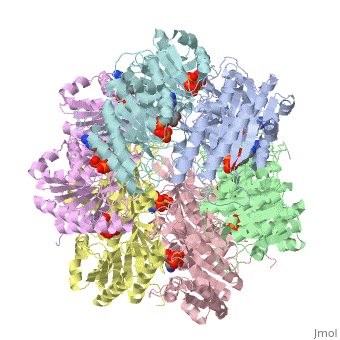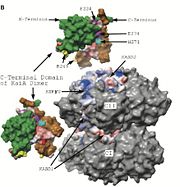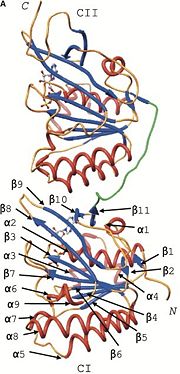Introduction
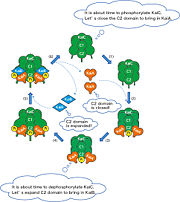
Interactions of KaiC with KaiA and KaiB
Biological Circadian Clocks are self-sustaining oscillators that function on a rhythmic cycle 24 hours. They exhibit a very precise time constant and temperature compensation, which allows the system to run at a steady rate independent of temperature fluctuations [1]. They are found in almost all organisms, the simplest of which are cyanobacteria, which have been extensively studied in order to determine the mechanism of the fine-tuned biological process of circadian rhythmicity. In most eukaryotes, a region of the brain called the superchiasmic nuclei detects light and dark cycles, then relays the message to biological clock systems that maintain rhythmicity within the body. Conversely, cyanobacteria have a fairly modest system comprised of three proteins: KaiC, KaiA, and KaiB. The system is based around the central protein KaiC which exhibits ATP binding, inter-subunit organization, a scaffold region for Kai protein complex formation, a location where critical mutations are found, and an evolutionary link to other well-known proteins [2]. In order to devise an explanation for the mechanism of biological oscillators, we need to characterize the structure, function, and interactions among molecular components. To study these, scientists begin with analyzing cyanobacteria such as Synechococcus elongatus, since it is the smallest organism that expresses rhythmic clock properties.
KaiC - KaiA - KaiB System
The system by which the protein complex maintains a precise time constant and temperature compensation is achieved by the cooperation of a three-protein network. In a nutshell, KaiC requires ATP so that it can autophosphorylate, while KaiA enhances this phosphorylation and KaiB antagonizes it. KaiC is the central clock protein, which has autokinase and autophosphorylase activity. Yet in the presence of ATP alone, KaiC cannot perform the autophosphorylation function. It requires two other proteins, KaiA and KaiB, the genes of which are found in the same cluster on the chromosome [2]. Although KaiC phosphorylates itself, the presence of KaiA and KaiB are essential to rhythmicity. KaiA stimulates KaiC autophosphorylation, possibly by stabilizing the phosphorylated form of KaiC. On the other hand, KaiB antagonizes the process possibly by enhancing KaiC dephosphorylation or interfering with the binding of KaiA to KaiC. Even in the presence of very high ATP, KaiB still prompts KaiC to dephosphorylate [3]. Therefore, we can see that ATP alone cannot trigger KaiC to maintain global rhythmicity. The mechanism is not well understood and is the focus of further study. Many possibilities have been proposed one of which is shown on the left. Here, the mechanism proposed involves KaiC altering the CII domain to attract KaiA. KaiA then binds KaiC to trigger autophosphorylation. KaiC alters the CII domain again to bring KaiB to the molecule the latter of which binds the KaiA-KaiC complex. KaiC is dephosphorylated by this interaction, and KaiA and KaiB dissociate from KaiC. The entire process starts again for a new circadian cycle [4].
KaiC Homohexameric Complex
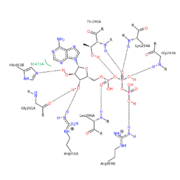
Intramolecular interactions of ATP binding site
The structure of KaiC resembles a double donut formation with a central pore through the center. Conceptually, it is comprised of two subunits, which appear as the two donuts. Yet, technically, the protein is divided perpendicular to the conceptual donut subdivision, which can be visualized as six that form a barrel-shaped structure. The entire molecule is made of 519 amino acid residues in each monomer and spans 100 Å in diameter. The waist of the molecule (the region between CI and CII) has a diameter of 62 Å. The that runs through the molecule is wider at the CI region, 22 Å, and narrows to a nearly that appears to be secured by six residues. The basic, polar nature and physical divergence of this CII pore in comparison to the CI end indicates the possibility of conformational change, such as closing and opening [2]. Although it is not believed to be directly associated with the autophosphorylation process, it may be a binding site for KaiA and/or KaiB.
There are 12 molecules of bound at the interface between monomers. Three potential phosphorylation sites have been identified within 10 Å of the .
KaiC Autophosphorylation Sites
The phosphorylation sites on the KaiC protein are essential to the system. This is because phosphorylation status corresponds to clock speed. The protein predominantly phosphorylates on threonine and serine residues, whose specific identification is not completely resolved. Nonetheless, three potential phosphorylation sites have been identified within 10 Angstroms of the ATP binding region in the CII domain [3]. The key autophosphorylation site is . When this residue is mutated, there is no circadian rhythm at all. The process is believed to demonstrate a transfer of the of ATP from one CII subunit to the T432 site on an adjacent subunit.
A region of each hexamer that is notable regarding the phosphorylation of KaiC is the . This zone is recognized as site for binding and hydrolysis of ATP. Along with the T432 site, evidence shows a shuttling of phosphates between residues of the P-Loop.
Based on RecA structure/function similarity, a conserved glutamate in CI is proposed to activate water for an attack on the gamma-phosphate of ATP in order to release the phosphate to be shuttled. The site within the A and B monomer and its interactions are displayed in the image on the right which shows hydrogen bonds and interactions between molecules which hold the ATP in the pocket.
KaiA - KaiC Interaction Site
KaiA is a protein that stabilizes the phosphorylation status of KaiC. One area that this enhancer is hypothesized to bind to is the interface of the two donut-shaped KaiC subunits, CI and CII. This area, known as the "waist" of the molecule, expresses head-to-tail orientation between CI and CII which regulates the essential phosphorylation by interacting with distant areas on the surface of the hexamer. The other possible site for KaiA binding is the CII region of the central pore. These two binding areas are shown to present complementarity between KaiC and KaiA. On KaiC, these regions are labelled KiaC Binding Domain 1, or CKABD1 at the waist, and KaiC Binding Domain 2, or CKABD2 at the CII central pore, or "dome". In the figure on the right, electrostatic surface potentials of the KaiC Binding Domain 1 (CKABD1) and KaiC Binding Domain 2 (CKABD2) regions are depicted. The convex shapes presented on both binding domains are compatible with the concave surface of the hypothesized binding region on KaiA. Also, the electrostatic surface potentials of the KaiC binding domains (mostly positive, colored in blue), and the electrostatic surface potentials of the concave binding region in KaiA (mostly negative, colored in red) are complementary.
It is believed that two dimers of KaiA interact with one hexamer of KaiC. This could be the reason for the two binding sites hypothesized.
In the KaiA binding domain of KaiC, a mutation of to a Histidine (a hydrophobic residue to a positively charged residue) lead to a 60 hour circadian period, a rhythm over twice the normal 24 hour period. This residue is located very close to the ATP binding region, indicating the possibility that the stronger binding of KaiA protects the ATP binding site to prolong its residence in the active site [2].
KaiB - KaiC Interaction Site
There is very little known about the interactions between KaiC and KaiB besides that KaiB antagonizes the effects of KaiA. Some possibilities based on the structure of the molecule indicate that KaiA and B compete for the same binding site, or that KaiC changes conformation of it's C-terminal domain to open to KaiB.
